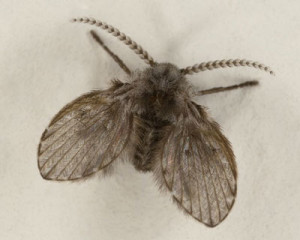How Can I Get Rid of Drain Flies?
By Chris Williams on January 12, 2015.
We’ve had a drain fly problem for months and months. We see them in both bathrooms. I know enough to know that they are apparently coming from the sink or tub drains. What I don’t know is how to get rid of them. Heavy-duty drain cleaners don’t work at all. What else can we do? B. A., Salem, NH
 It can be tough, and sometimes impossible, to get rid of drain flies on your own. Successful DIY treatment is time-consuming and usually involves repeat applications and scrubbing of drain pipes to remove the scum.
It can be tough, and sometimes impossible, to get rid of drain flies on your own. Successful DIY treatment is time-consuming and usually involves repeat applications and scrubbing of drain pipes to remove the scum.
Drain flies are also called moth flies because of their fuzzy wings and because they hold their wings out to the side, mothlike. They’re so tiny though (1/16-1/4 inch long) that these details may be hard to see. Their habits are more telling. They are weak fliers and fly in jerky hops from wall to wall. They stay pretty close to the drains where the female lays her eggs in the scummy, gelatinous goo that accumulates deep down in the drainpipe. The wormlike, semiaquatic larvae feed on this stuff, pupate, and adult flies later emerge from the drain.
It Take a Lot to Kill Drain Fly Larvae
Adult drain flies can be killed simply by swatting them, or with household insecticide sprays, but new adults will continue to emerge from the drains. It’s not your imagination that household drain cleaners don’t work well to eliminate the larvae. Neither does flushing the drain with boiling water or bleach, and you definitely don’t want to be pouring pesticide down your drain. Any DIY drain fly treatment also must involve scrubbing the goo out of the drain with a long-handled, stiff brush. It’s important to treat all drains at the same time so that flies do not lay their eggs in untreated drains.
A Professional Can Make it Look Easy
You’re better off contacting a professional exterminator. We have specialty enzyme drain cleaning foamers or gels that work by eliminating the organic material that accumulates inside pipes and that feeds the drain fly larvae. These thick biological cleaners cling to pipes and drain traps where they slowly digest the gelatinous scum and suffocate the drain fly larvae. The good thing about this treatment, besides the fact that it works, is that no pesticides are involved and the biocide product is not hazardous to people or pipes.
It’s Not Always the Drains…or Drain Flies
It’s always possible that scummy drains are not the source of the drain flies (although that doesn’t seem likely in your case). Some other, but less likely, indoor breeding sites for drain flies are: potted plant saucers, scummy garbage cans, drip pans, sump pump, and floor drains. In the worst case scenario, indoor drain flies can come from a sewage line break under the slab. Simple drain cleaning won’t solve this problem; you’ll need a plumber. Another reason why you should involve an exterminator who can inspect to locate the source(s) of the flies.
During warm weather months, drain flies can breed outside in clogged roof gutters, dirty bird baths or bird feeders, air conditioner drain pans, failing septic tanks, compost piles, or even in wet mulch or decaying vegetation. They can then find their way inside through torn screens or open doors and windows. Drain flies are attracted to lights and are active at night.
There are also at least three other small flies or gnats that are found indoors in similar situations (see Tracking Down Indoor Gnats). You need to be sure you know what you’re dealing with. Give Colonial Pest a call!
By Sanjay Acharya (Own work) [CC BY-SA 3.0 or GFDL], via Wikimedia Commons
Stay up-to-date with Colonial Pest’s email newsletter!